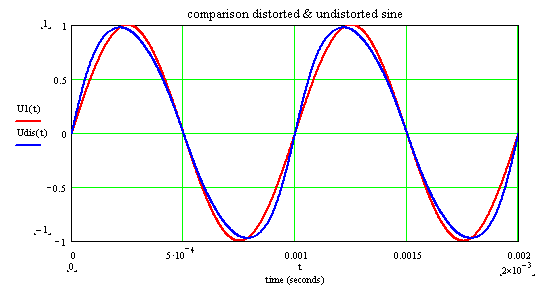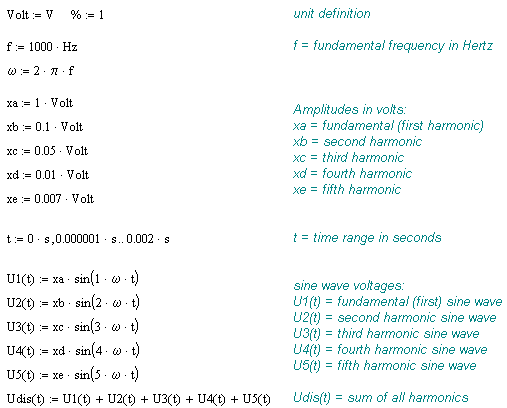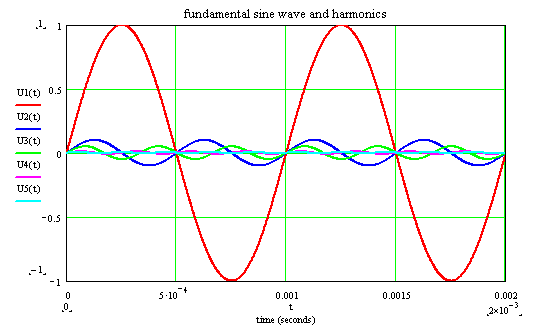Measurement distortion factor
A measuring instrument which can
divide the distorted voltages into their spectral portions, is necessary
for. A spectrum analyzer or FFT analyzer is very well suitable. They
measure the amplitudes of the harmonious frequencies. The measured values
must be processed thereafter with the distortion factor equation.
Example of a measurement with the spectrum analyzer
|
|

|
The picture shows the spectrum of an
amplifier, measured with a Hewlett Packard
HP 3580A
spectrum analyzer. It shows a fundamental wave of 10 kHz, a second
harmonic with 20 kHz and the third harmonic with 30 kHz. The
amplitudes amount to: xa=(0dB) 1 V, xb=(-34dB) 20 mVolt, xc=(-78dB)
126 µVolt
Calculation with
the distortion factor equation:
 |
The distortion factor amounts to
nevertheless 2 %. The principal part by the distortion factor
is the second harmonic. Odd-numbered third harmonic is very
small. The measurement originates from the attempt
Hifi amplifier with tubes sound
|
|
Another method the distortion
factor to measure are special measuring instruments, e.g. a HEWLETT
PACKARD HP8903A or HP8903B. This distortion factor of these instruments
work according to another principle. They use an adjustable filter, which
can reject the fundamental from the total signal. They do not use the
computation with distortion factor equation. The indicated result is the
total harmonic distortion plus noise THD+N. THD+N is ever larger in
practice than the purely harmonious distortion factor THD.
|
Distortion factor and Hifi amplifier
Again, the equation for the distortion factor gives only a number. This
number says something about the size of the distortion factor, however
nothing about the spectral composition. The spectral composition is very
important for a Hifi amplifier. The question is: the weighting of the
even-numbered or do the odd-number cause the harmonious distortion factor?
If the distortion factor consists predominantly of even-numbered
harmonious ones, then these distortions are clearly less audible. If the
principal parts are however odd-number, the distortions are clearly more
audible. Therefore e.g. the specification of the distortion factor in the
folder of a Hifi amplifier is to be always regarded with caution. A
distortion factor of e.g.. 1 %, are not a world fall, if it concerns only
even-numbered harmonious. Consist this 1 % however of odd-number
harmonious ones, they are surely clearly more audible. Besides, the most
important at the indication of the distortion factor is not the exact
amount or the number of zeros. Surely, the order of magnitude is of
importance, very importantly however is the spectral composition of the
distortion factor. Also the boundary conditions of the measurement are to
be considered. At the edge noticed, the most important at the indication
of the distortion factor is not the accurate number or the amount of the
zeros. The order of magnitude is safe, importantly is already, very
importantly naturally the spectral composition of the distortion factor.
Important are also the boundary conditions of the measurement. The
boundary conditions are e.g. the indication of: load impedance at the
amplifiers output, output voltage, signal frequency and temperature of the
output stage. The boundary conditions have much influence on the
distortion factor. Often in an amplifier folder is indicated only rarely
the spectral composition of the signal, still more rarely the boundary
conditions of the measurement. From electrotechnical view that is
incomplete results of measurement. The economical aspect is another.
|
Distortion factor and mathematician
this person's group does
not have problems with the distortion factor. From mathematical view this
equation is simplest toy.
Distortion factor and theoretician
have it already more
heavily. It must think over the causes its and develop models for it.
Distortion factor and practical man
the poor boy has it most heavily. He gets an equation from the
mathematician and from the theoretician a theory. Both say to him like
distortion factor develop and as he to be computed are. The theoretician
says also which against it to be done is. The practical man tries it out
and announces: it did not always function. He builds already for a long
time at his circuit and gets ever more the opinion: the topic is extremely
complicated and in the refinement hardly still theoretically controllable.
In particular with the task to increase the zeros behind the comma still
further. In practice inserting of zeros is far behind the comma a lengthy
task, which can degenerate into a life's work.
|





